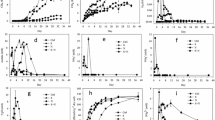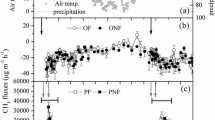Abstract
Methanogenic archaea are strict anaerobes and demand highly reduced conditions to produce methane in paddy field soil. However, methanogenic archaea survive well under upland and aerated conditions in paddy fields and exhibit stable community. In the present study, methanogenic archaeal community was investigated in fields where paddy rice (Oryza sativa L.) under flooded conditions was rotated with soybean (Glycine max [L.] Merr.) under upland conditions at different rotation histories, by polymerase chain reaction (PCR)-denaturing gradient gel electrophoresis (DGGE) and real-time quantitative PCR methods targeting 16S rRNA and mcrA genes, respectively. Soil samples collected from the fields before flooding or seeding, during crop cultivation and after harvest of crops were analyzed. The abundance of the methanogenic archaeal populations decreased to about one-tenth in the rotational plots than in the consecutive paddy (control) plots. The composition of the methanogenic archaeal community also changed. Most members of the methanogenic archaea consisting of the orders Methanosarcinales, Methanocellales, Methanomicrobiales, and Methanobacteriales existed autochthonously in both the control and rotational plots, while some were strongly affected in the rotational plots, with fatal effect to some members belonging to the Methanosarcinales. This study revealed that the upland conversion for one or longer than 1 year in the rotational system affected the methanogenic archaeal community structure and was fatal to some members of methanogenic archaea in paddy field soil.




Similar content being viewed by others
References
Angel R, Matthies D, Conrad R (2011) Activation of methanogenesis in arid biological soil crusts despite the presence of oxygen. PLoS One 6:e20453
Angel R, Claus P, Conrad R (2012) Methanogenic archaea are globally ubiquitous in aerated soils and become active under wet anoxic conditions. ISME J 6:847–862
Aoki S (1996) Black-box: data analysis on the http://aoki2.si.gunma-u.ac.jp/BlackBox/BlackBox.html. Accessed 23 January 2014
Asakawa S, Hayano K (1995) Population of methanogenic bacteria in paddy field soil under double cropping conditions (rice-wheat). Biol Fertil Soils 20:113–117
Asakawa S, Akagawa-Matsushita M, Koga Y, Hayano K (1998) Communities of methanogenic bacteria in paddy field soils with long-term application of organic matter. Soil Biol Biochem 30:299–303
Brioukhanov A, Netrusov A, Sordel M, Thauer RK, Shima S (2000) Protection of Methanosarcina barkeri against oxidative stress: identification and characterization of an iron superoxide dismutase. Arch Microbiol 174:213–216
Brioukhanov AL, Thauer RK, Netrusov AI (2002) Catalase and superoxide dismutase in the cells of strictly anaerobic microorganisms. Microbiology (Mosc) 71:281–285
Degelmann DM, Kolb S, Dumont M, Murrell JC, Drake HL (2009) Enterobacteriaceae facilitate the anaerobic degradation of glucose by a forest soil. FEMS Microbiol Ecol 68:312–319
Eusufzai MK, Tokida T, Okada M, Sugiyama S, Liu GC, Nakajima M, Sameshima R (2010) Methane emission from rice fields as affected by land use change. Agric Ecosyst Environ 139:742–748
Fetzer S, Bak F, Conrad R (1993) Sensitivity of methanogenic bacteria from paddy soil to oxygen and desiccation. FEMS Microbiol Ecol 12:107–115
Hu H-W, Zhang L-M, Yuan C-L, He J-Z (2013) Contrasting Euryarchaeota communities between upland and paddy soils exhibited similar pH-impacted biogeographic patterns. Soil Biol Biochem 64:18–27
Lee HJ, Kim SY, Kim PJ, Madsen EL, Jeon CO (2014) Methane emission and dynamics of methanotrophic and methanogenic communities in a flooded rice field ecosystem. FEMS Microbiol Ecol 88:195–212
Liu C-T, Miyaki T, Aono T, Oyaizu H (2008) Evaluation of methanogenic strains and their ability to endure aeration and water stress. Curr Microbiol 56:214–218
Liu D, Suekuni C, Akita K, Ito T, Saito M, Watanabe T, Kimura M, Asakawa S (2012) Effect of winter-flooding on methanogenic archaeal community structure in paddy field under organic farming. Soil Sci Plant Nutr 58:553–561
Luton PE, Wayne JM, Sharp RJ, Riley PW (2002) The mcrA gene as an alternative to 16S rRNA in the phylogenetic analysis of methanogen populations in landfill. Microbiology 148:3521–3530
Ma K, Lu Y (2011) Regulation of microbial methane production and oxidation by intermittent drainage in rice field soil. FEMS Microbiol Ecol 75:446–456
Minami K (1994) Methane from rice production. Fertil Res 37:167–179
Nicol GW, Glover LA, Prosser JI (2003) Molecular analysis of methanogenic archaeal communities in managed and natural upland pasture soils. Glob Chang Biol 9:1451–1457
Nishida M, Sekiya H, Yoshida K (2013) Status of paddy soils as affected by paddy rice and upland soybean rotation in northeast Japan with special reference to nitrogen fertility. Soil Sci Plant Nutr 59:208–217
Nishimura S, Sawamoto H, Akiyama S, Sudo W, Cheng W, Yagi K (2005) Continuous automated nitrous oxide measurements from paddy soils converted to upland crops. Soil Sci Soc Am J 69:1977–1986
Nishimura S, Akiyama H, Sudo S, Fumoto T, Cheng W, Yagi K (2011) Combined emission of CH4 and N2O from a paddy field was reduced by preceding upland crop cultivation. Soil Sci Plant Nutr 57:167–178
Peters V, Conrad R (1996) Sequential reduction processes and initiation of CH4 production upon flooding of oxic upland soils. Soil Biol Biochem 28:371–382
Poplawski AB, Mårtensson L, Wartiainen I, Rasmussen U (2007) Archaeal diversity and community structure in a Swedish barley field: specificity of the Ek510R/(EURY498) 16S rDNA primer. J Microbiol Methods 69:161–173
Scavino AF, Ji Y, Pump J, Klose M, Claus P, Conrad R (2013) Structure and function of the methanogenic microbial communities in Uruguayan soils shifted between pasture and irrigated rice fields. Environ Microbiol 15:2588–2602
Shima S, Sordel-Klippert M, Brioukhanov A, Netrusov A, Linder D, Thauer RK (2001) Characterization of a heme-dependent catalase from Methanobrevibacter arboriphilus. Appl Environ Microbiol 67:3041–3045
Shirato Y, Yagasaki Y, Nishida M (2011) Using different versions of the Rothamsted Carbon model to simulate soil carbon in long-term experimental plots subjected to paddy-upland rotation in Japan. Soil Sci Plant Nutr 57:597–606
Simankova MV, Kotsyurbenko OR, Lueders T, Nozhevnikova AN, Wagner B, Conrad R, Friedrich MW (2003) Isolation and characterization of new strains of methanogens from cold terrestrial habitats. Syst Appl Microbiol 26:312–318
Takahashi T, Sumida H, Nira R (2013) A new framework for study of irrigated paddy rice and upland crops rotation farming and its relation to soil and plant nutrition science. 1. Advances and perspectives in irrigated paddy rice and upland crop rotation farming. Jpn J Soil Sci Plant Nutr 84:202–207 (in Japanese)
Tamura K, Peterson D, Peterson N, Stecher G, Nei M, Kumar S (2011) MEGA5: Molecular evolutionary genetics analysis using maximum likelihood evolutionary distance and maximum parsimony methods. Mol Biol Evol 28:2731–2739
Watanabe T, Kimura M, Asakawa S (2006) Community structure of methanogenic archaea in paddy field soil under double cropping (rice-wheat). Soil Biol Biochem 38:1264–1274
Watanabe T, Kimura M, Asakawa S (2007) Dynamics of methanogenic archaeal communities based on rRNA analysis and their relation to methanogenic activity in Japanese paddy field soils. Soil Biol Biochem 39:2877–2887
Watanabe T, Kimura M, Asakawa S (2009) Distinct members of a stable methanogenic archaeal community transcribe mcrA genes under flooded and drained conditions in Japanese paddy field soil. Soil Biol Biochem 41:276–285
Watanabe T, Hosen Y, Agbisit R, Llorca L, Katayanagi N, Asakawa S, Kimura M (2013) Changes in community structure of methanogenic archaea brought about by water-saving practice in paddy field soil. Soil Biol Biochem 58:235–243
Watanabe T, Wang G, Taki K, Ohashi Y, Kimura M, Asakawa S (2010) Vertical changes in bacterial and archaeal communities with soil depth in Japanese paddy fields. Soil Sci Plant Nutr 56:705–715
Acknowledgments
This study was supported in part by a Grant-in-Aid (Soil eDNA) from the Ministry of Agriculture, Forestry and Fisheries of Japan.
Author information
Authors and Affiliations
Corresponding author
Additional information
Accession number: The Genbank/EMBL/DDBJ accession numbers for the 16S rRNA gene sequences of methanogenic archaea are AB 915261-AB 915320.
Electronic supplementary material
Below is the link to the electronic supplementary material.
Supplemental Figure 1
(PPTX 1440 kb)
Supplemental Table 1
(PDF 248 kb)
Rights and permissions
About this article
Cite this article
Liu, D., Ishikawa, H., Nishida, M. et al. Effect of Paddy-Upland Rotation on Methanogenic Archaeal Community Structure in Paddy Field Soil. Microb Ecol 69, 160–168 (2015). https://doi.org/10.1007/s00248-014-0477-3
Received:
Accepted:
Published:
Issue Date:
DOI: https://doi.org/10.1007/s00248-014-0477-3




